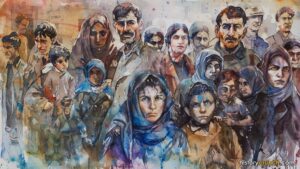The Philippine-American War was fought from February 4th, 1899, until July 2nd, 1902 and was a significant conflict during the era of American Imperialism in the Gilded Age. The war marked an important chapter in both American and Filipino history and was pivotal in shaping the histories of both countries. This article explores the causes, major events and impacts of the Philippine-American War.
PHILIPPINE-AMERICAN WAR – CAUSES
Historians have identified several significant causes of the Philippine-American War, including: Filipino Independence Movements and American Imperialism.
The Philippine-American War occurred following the events of the Spanish-American War, which ended with the signing of the Treaty of Paris in December of 1898. Under the terms of the treaty, Spain was forced to give up the Philippines to the United States for $20 million. However, this transfer of sovereignty was not accepted by the Filipino revolutionaries, who had been fighting for independence from Spanish colonial rule since 1896. Led by Emilio Aguinaldo, Filipino nationalists declared independence from Spain on June 12th, 1898, and established the First Philippine Republic. They hoped to gain recognition and support from the United States. However, American imperialist interests were high at the time and led to increased tensions between the nations.
The American government, under President William McKinley, believed in expanding American influence and saw the Philippines as a strategic asset for economic and military purposes. As stated above, this was the era of American Imperialism, which ultimately caused the United States to clash with Filipino aspirations for independence and self-rule.
In the end, the presence of American troops in the Philippines and their refusal to recognize the First Philippine Republic created tensions between the two nations. These tensions escalated into open conflict on February 4th, 1899, when a skirmish broke out between American and Filipino forces near Manila.
PHILIPPINE-AMERICAN WAR – MAJOR EVENTS
The Philippine-American War unfolded as a series of significant events. More specifically, it contained several phases and strategies, with significant battles and campaigns that defined the conflict. In fact, the war began with intense fighting around Manila, a major urban center in the Philippines. The superior firepower and organization of the American forces initially overwhelmed the Filipino troops, leading to the capture of key locations.
After suffering defeats in conventional battles, Filipino forces shifted to guerrilla tactics. They used hit-and-run attacks, ambushes, and sabotage, making it difficult for the American military to maintain control. The American military responded with a combination of military campaigns and harsh tactics, including the establishment of concentration camps, destruction of villages, and implementation of a ‘scorched earth’ policy. These methods aimed to break the resistance but resulted in significant civilian suffering.
In March of 1901, American forces captured Emilio Aguinaldo, the leader of the Filipino resistance. His capture dealt a severe blow to the Filipino struggle, although sporadic fighting continued.
PHILIPPINE-AMERICAN WAR – IMPACTS
The Philippine-American War had profound and lasting impacts for both the United States and the Philippines. For example, in terms of death, the war resulted in a significant loss of life. For example, it is believed that the Philippine forces suffered as many as 20,000 military deaths during the war. However, historians also believe that as many as 250,000 Filipino civilians died during the conflict, with most dying from starvation and disease. The American military also suffered casualties, though on a smaller scale. For instance, the Americans suffered 4,200 military deaths and another 2,800 casualties. It’s important to note that these figures are estimates and historians disagree on the exact numbers, especially in relation to the Filipino civilian deaths.
The next main impact was the increased role of the United States in terms of imperialism and colonial rule. For example, the Philippines remained under American colonial rule until 1946. During this period, the United States implemented various reforms in the Philippines. These reforms focused on educational and infrastructure development but also suppressed Filipino nationalist movements and imposed American cultural values. This was a relatively common practice during the Age of Imperialism by most colonial powers, however, it had negative impacts on the culture and society of the Philippines.
As such, the war increased Filipino nationalism and resistance to American imperialism. Despite the defeat, the desire for independence persisted, eventually leading to the establishment of the Commonwealth of the Philippines in 1935 and full independence in 1946.
Finally, the war marked a significant moment in the history of American imperialism. More specifically, it demonstrated the United States’ willingness to use military force to achieve its economic and strategic objectives. With that said, the war raised ethical and moral questions about American foreign policy and the justification for imperialism. It sparked debates within the United States about the country’s role in the world and its commitment to democratic principles.


